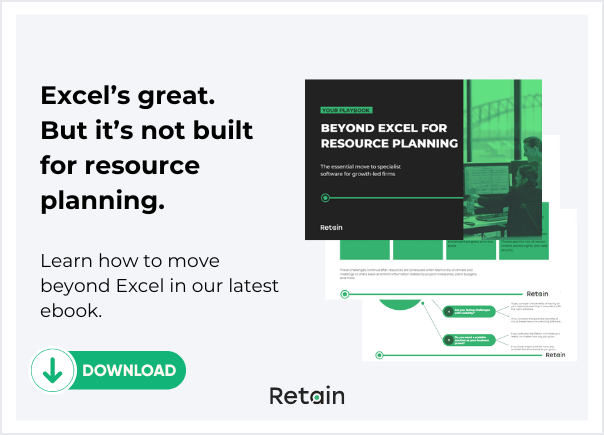With specialist skill shortages at an 18-year high in Q1 2024, there’s huge pressure to maximise workforce efficiency. Yet pushing utilisation rates above 80% can lead to burnout and decreased productivity.
So how do you strike the right balance? That's where data analytics comes in.
For too long, workforce planning has relied heavily on gut instinct and basic spreadsheets. But this approach simply isn't enough today. Modern workforce planning software, powered by data and analytics, is changing how organisations manage their most valuable asset—their people.
In this blog, we'll explore practical ways to leverage data analytics in your workforce planning strategy. Let’s get into it.
Beyond spreadsheets: Simplifying workforce planning
Remember when workforce planning meant updating endless spreadsheets and hoping your projections were somewhere near accurate? Those days are rapidly becoming history—and for good reason.
Manual workforce planning creates significant blind spots. Without real-time data, you're essentially planning in the dark. Here's what we typically see:
❌ Resource managers spending hours updating spreadsheets instead of focusing on strategic decisions
❌ Delayed responses to changing project demands
❌ Missed opportunities to optimise resource allocation
❌ Disconnected systems leading to data inconsistencies
❌ Limited visibility into actual versus planned utilisation
For more on this, you might enjoy our new ebook “Beyond Excel for resource planning”.

On the other hand, when you use workforce planning software, like Retain, within minutes, you can see exactly who's available, what skills they have, and how their experience aligns with the project needs. This isn't just about having a fancy dashboard—it's about having confidence in your decisions when it matters most.
Instead of static spreadsheets that are outdated before they're even finished, you're working with live data that shows you the true state of your workforce, like in this example below.

But real-time visibility is just the beginning. One of the biggest benefits is the ability to see what's coming. Data-driven planning helps you spot patterns and trends before they become problems—or opportunities before your competitors do.
Take skills gaps, for example. Rather than finding out you're short on key skills when a new project lands, predictive analytics helps you spot potential shortages months in advance. This means you can start upskilling existing team members or adjust your recruitment strategy well before it becomes urgent.
Connecting the dots
Here's where it gets really interesting. When your workforce planning connects with broader business objectives, you start seeing patterns you might have missed. You might notice that your most profitable projects always involve a particular mix of senior and junior staff. Or that certain types of projects consistently run into resource constraints during specific months.
These insights help you make better decisions about everything from proposal pricing to recruitment planning.
Of course, this might all sound a bit too perfect. The truth is, implementing data-driven workforce planning isn't like flipping a switch. It requires careful thought, the right tools, and a clear strategy. But the payoff—in terms of better decisions, happier clients, and more engaged employees—makes it worth the effort.
Want to know how to actually implement this in your organisation? Let's explore that next.
Putting data-driven workforce planning into action

You've seen the potential of data-driven workforce planning. Now comes the crucial part—making it work in your organisation. And let's be honest: this is where many transformation initiatives stumble.
#1. Start with the basics
Dean McCormack, a Director at Rickard Luckin, faced a familiar challenge. His team was trapped in Excel spreadsheet chaos—only one person could access their resource planning sheet at a time, creating bottlenecks and scheduling conflicts that rippled through the organisation.
"We knew we needed to move beyond spreadsheets," Dean explains, "but we were worried about disrupting our existing processes." It's a common concern we hear. The fear of change can often paralyse decision-making, keeping teams stuck with inefficient systems.
Dean’s team needed a solution that could eliminate scheduling conflicts while feeling familiar enough to ensure user adoption.
This approach illustrates an important principle: successful implementation starts with solving real problems, not chasing fancy features. For Rickard Luckin, this focused approach paid off. They've not only resolved their immediate scheduling challenges but have also achieved thousands of time savings through reduced admin burden.
#2. Choosing the right tools
When it comes to choosing workforce planning software, one size definitely doesn't fit all. Success lies in finding a solution that aligns with your specific needs.
Three key capabilities should drive your decision. First, look for intelligent resource recommendations that can analyse skills, experience levels, and availability to suggest the best project fits. Second, ensure the system offers robust reporting and analytics—you'll need customisable dashboards and clear visualisation tools to make sense of your workforce data. Finally, prioritise solutions that offer dynamic skills matching to ensure your projects are staffed with the right expertise from day one.
Let's be practical about integration too. Your chosen solution should slot seamlessly into your existing tech stack, connecting with your HR systems, project management tools, and financial platforms. Think of it as adding a new player to an established team—they need to work well with everyone else.
And don't forget about scalability. Today you might need basic resource scheduling, but what about when your team doubles in size? Your chosen solution should be able to scale alongside your business, adapting to new challenges as they emerge.
#3. The people factor
We’ve briefly touched on this, but it’s something that often gets overlooked: the best technology in the world won't help if your people don't use it. Dean McCormack shares his advice for those considering workforce planning software:
“Do not let cost be the primary driver,” he admits. “When choosing a solution, ensure it is not entirely unfamiliar to your users. Implementation goes beyond software; behavioural change and accurate data input are crucial. Be brave and embrace change.
The lesson? Change management isn't just a buzzword—it's essential. This means choosing solutions that feel familiar to Excel and easy to use, involving key stakeholders early, providing comprehensive training, and showing people how the new system will make their lives easier.
#4. Measuring success
How do you know if your implementation is working? Look for early wins. Are project managers spending less time searching for available resources? Has your resource utilisation improved? Are you seeing fewer last-minute staffing scrambles?
Gerald Edelman saw their utilisation rates increase by 5-10%. More importantly, they started spotting potential resource conflicts weeks in advance, rather than days.
#5. The continuous improvement loop
Remember: implementing workforce planning software isn't a one-and-done exercise. It's an ongoing process of refinement and improvement. Use the data you're gathering to keep optimising your approach. Are certain types of projects consistently running over capacity? Are particular skills in constant demand? These insights help you make better decisions about hiring, training, and resource allocation.
Ready to take the next step in your workforce planning journey? Let's talk about how to get started.
Transform workforce planning: your next steps
In a talent-stretched market, being able to make smart, informed decisions about your workforce is essential for survival and growth.
Think about where you are now. Perhaps you're struggling with resource conflicts, or finding it difficult to predict future capacity needs. Maybe you're concerned about rising costs or falling utilisation rates. These are exactly the challenges that data-driven workforce planning addresses.
But here's the most important point: every day you continue with outdated planning methods is a day you're leaving value on the table. Whether that's through missed opportunities, inefficient resource allocation, or simply time wasted on manual processes.
The good news? You don't have to transform everything overnight. Start with one area where better insights would make an immediate difference. It might be:
- Getting clearer visibility of your current resource allocation
- Understanding your true capacity for taking on new work
- Identifying skills gaps that are holding you back
Take that first step. Book a demo to see how workforce planning software could transform your organisation. Or if you're not ready for that yet, start by auditing your current planning processes. Either way, remember that in today's competitive landscape, standing still isn't an option.
Want more insights on workforce planning and resource optimisation? Subscribe to our newsletter for regular updates and expert tips.


